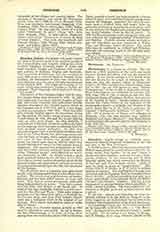

Cherokee Indians, the largest and most important tribe of Iroquoian stock of the southern section of the United States, and formerly holding the whole southern Alleghany mountain region of North and South Carolina, Georgia and Tennessee, with considerable portions of Alabama, Virginia and Kentucky. They now reside in Oklahoma, with the exception of some 1300 souls on reserved lands in Western North Carolina, the descendants of those who remained in their old home when the rest of the tribe was removed to the West in 1839. The origin and meaning of the name, which they pronounce Tsaragi or Tsalagi, are unknown. They commonly call themselves Yanwiya, “real people”.
The history of the Cherokees begins with De Soto, who passed within their territory in 1540. In 1684 they made their first treaty with the English of Carolina, with whom thereafter they maintained friendly relations throughout the Colonial period, except in the Yamasee war in 1715-1716, and in a war waged on their own account in 1759-1761. They took sides also with the English against the Americans during the Revolution, but made a treaty of peace with the United States in 1785, although the border fighting went on some years longer. In 1821 Sequoya, a mixed-blood of the tribe, invented a syllabic alphabet for the language which has been an immense factor in their progress toward civilization. In 1827 they adopted a regular form of government modeled upon that of the United States, but after long controversy with the State of Georgia, which claimed jurisdiction over most of their territory not already ceded, a treaty was forced upon them in 1835 by which they bound themselves to remove to their present home in Oklahoma. The removal was accomplished in 1839, and their tribal existence continued under the style of the “Cherokee Nation”, until dissolved for American citizenship in 1906. As already noted, a small body remained behind in the old home in the East. The tribe at present numbers altogether about 20,000 persons of pure and mixed blood, exclusive of several thousand names carried upon the rolls, but repudiated by the Indians.
The Cherokees were a sedentary and agricultural people, with hunting and fishing as subordinate occupations. The women were expert potters and basket-weavers, and the men skillful carvers of stone and wood. They had no central government, each town being independent in its action. They had a system of seven clans, with descent in the female line. In religion they were pantheists, holding in special reverence the Sun, Fire and Water. Their great religious ceremony was the Green Corn dance, a thanksgiving for the new crops; and their chief athletic amusement was a ball-game which is the original of our lacrosse. They buried their dead in caves or under piles of stones.
The story of a Cherokee mission as early as 1643 must be regarded as apocryphal. So far as known, the first Christianizing, or at least civilizing effort among them was undertaken about 1736 by Christian Priber, possibly a Jesuit, but more probably a French officer or agent, who established himself among them, learned the language, organized the tribal government upon a civilized basis, and taught them the principles of Christian morality for some years, until he was seized by the English and conveyed to Charleston, South Carolina, where he died in prison. In 1801 the Moravians began work among the tribe, and were followed by Congregationalists, Presbyterians and Baptists. Catholic mission schools, in whole or part for Cherokees, are now conducted at Vinita, Tulsa, and Muscogee, Indian Territory. The whole tribe may be considered as civilized and Christian, although still retaining much of the old time belief and custom.
JAMES MOONEY

